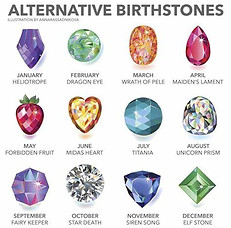Stone Information
Diamonds
How to choose the perfect diamond:
There are 4 important factors to consider when selecting a diamond, namely cut, colour, clarity and carat weight. These 4 aspects, referred to as the 4C’s of diamond valuation, determine the quality and price of the diamond.
1. Cut
The cut of a diamond creates its brilliance or ‘sparkle’. It refers to the facets of the diamond and the way in which they are positioned in relation to one-another in order to interact with light. A diamond my appear dull if cut incorrectly. The diamond cut quality is graded on a scale from excellent to poor and measured according to:
-
Brilliance: White light reflection
-
Fire: Dispersion of light into rainbow colours
-
Scintillation: Sparkle and interplay between light and dark areas
2. Colour
The colour of a diamond is graded according to the absence of colour, the more clear, the greater the value. Diamonds are measured according to the GIA’s diamond colour grade-scale from D-Z, D being colourless and Z slightly brown. Fancy colour diamonds are determined by displaying a hue greater than Z, or emitting colour other than yellow or brown.
According to commercial standards, H-I colour stones are considered excellent quality, whilst an I-J is also classified as commercial white.
When the scale reaches K, a very slight tint of yellow/brown becomes visible.

3. Clarity
Diamonds often contain small imperfections, as a result of their formation. These imperfections are analysed according to their size, shape and position and affects the value of the diamond. The clarity of diamonds is graded according to the scale below:

4. Carat Weight
The carat weight is an exact reflection of the diamond weight, thus determining the diamond size.

5. Diamond Shapes
There are various diamond shapes to choose from when designing an engagement ring. The diamond shape differs from the diamond cut; the shape describes the outline of the diamond from the top view, whilst the cut refers to the diamond facets. The diamond shape often affects the brilliance or ‘sparkle’ of the stone, therefore, round brilliant cut diamonds is the most popular. Stone shapes other than round are referred to as fancy shapes. Design a truly unique engagement ring by incorporating a fancy stone shape.

6. Certification
In order to assure our clients of the diamond characteristics and quality, all diamonds 0.5ct and larger are certified by a reputable diamond testing laboratory. The diamond is tested and graded according to the 4C’s using the latest technology and provided with a unique serial number. Diamond grading laboratories include GIA (Gemological Institute of America), EGL (European Gemological Laboratory) and SGL (Scientific Gemological Laboratory).
Moissanite
Engagement ring on a tight budget? Or looking for an environmentally friendly gem option?
Moissanite may be your solution. Moissanite is a fantastic diamond alternative, at a fraction of the cost.
Where it all began
Moissanite was first discovered by French scientist, Henry Moissan, inside a crater created by a meteorite. Moissan thought he had discovered diamonds, but later found out that the particles were silicon carbide. Moissanites retailed today are lab-created as natural Moissanite is extremely rare.
Why Moissanite
Why not? They are extremely affordable, environmentally sustainable and excellent quality gemstones. By visual comparison Moissanite and diamonds appear very similar, the only notable difference by closer inspection is the brilliance. Moissanite emits a heightened brilliance which may be described as “fiery rainbow flashes” ; it has a refractive index of 2.65-2,69, higher than the refraction of a diamond.
Is it a quality choice
Gemstones are measured on the Mohs Scale of Hardness, which assesses a gem’s ability to withstand surface scratching. A diamond is the hardest known mineral measuring 10 on Mohs scale, in comparison to Moissanite measuring 9.25. Moissanite is harder than Corundum (Rubies & Sapphires) and is more than suitable for every-day wear. Moissanite has almost zero impact on the environment as no mining is required for the supply of the stone, making it a wonderful eco-conscious gemstone option.
How to choose a Moissanite
Moissanites are available in a large variety of cuts, sizes, as well as fancy colours. Regarding general white Moissanites, they are only graded in terms of colour, opposed to the 4C’s of a diamond. A DEF or GH colour grading would be suitable for an engagement ring. Moissanites pair very well with diamond ascents or side-stones.
Lab grown diamonds
Lab grown diamonds are grown in highly controlled laboratory environments, using advanced technological processes that duplicate the conditions under which diamonds naturally develop when they form in the mantle, beneath the Earth’s crust. These lab created diamonds consist of actual carbon atoms arranged in the characteristic diamond crystal structure. Since they are grown from the same material as natural diamonds, they exhibit the exact same optical and chemical properties.
Lab created diamonds are available in a variety of colorless ranges, as well as in fancy colors. Fancy colored lab grown diamonds sell at comparatively reasonable prices compared to their natural colored diamond counterparts.
Some advantages of a lab created diamond:ad
-
Higher spec diamonds are easier accessable
-
Environmentally friendly
-
Greater affordability
-
Colors that are rarely found in nature can be created, making unique and coveted pieces more obtainable
-
Trackable origin sources allow you to source diamonds from reputable places that don't engage in poor treatment of workers or communities
When choosing a lab grown diamond, you can invest in a high-quality and stunning piece that is also ethical and environmentally friendly.


